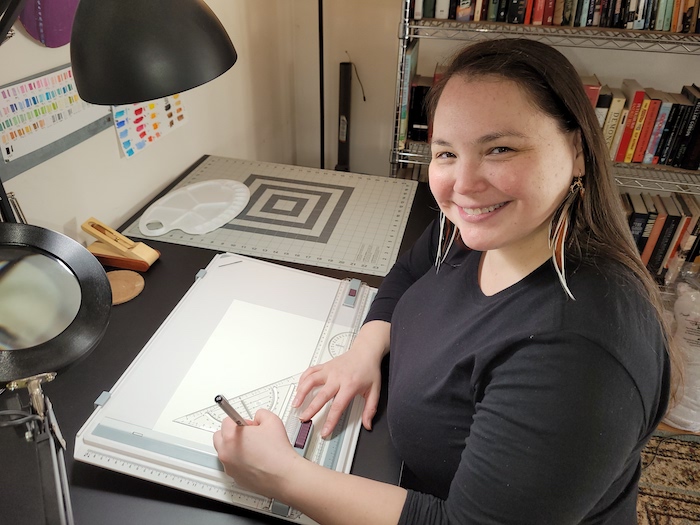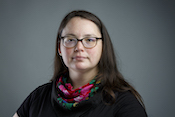By: Napatsi Folger, alumna of the Inuit Futures in Arts Leadership: The Pilimmaksarniq/Pijariuqsarniq Project, and Associate Editor for Inuit Art Quarterly

Introduction by Danielle Aimée Miles, Research and Administrative Coordinator, Inuit Futures in Arts Leadership: The Pilimmaksarniq / Pijariuqsarniq Project
Inuit Futures in Arts Leadership: The Pilimmaksarniq / Pijariuqsarniq Project is a seven-year Partnership Grant funded through the Social Sciences and Humanities Research Council of Canada that supports Inuit and Inuvialuit to become leaders within their communities in all areas of the arts. The project focuses on providing hands-on mentoring and training opportunities for Inuit Futures Ilinniaqtuit (students/learners) who undertake research in the arts, participate in other Inuit-led artistic projects, or gain valuable skills and knowledge by participating in paid internships within our network of arts institutions across the Canadian North and South. These experiences improve their readiness for careers in the arts across the North and South as well as creating a new generation of knowledge creators.
The Pilimmaksarniq / Pijariuqsarniq Project is led by an all-Inuit team of researchers and arts practitioners from across Inuit Nunangat (the four Inuit regions of Canada), and includes dedicated partners from colleges and universities across Canada, Arctic arts organizations, and arts institutions in southern Canada that have committed to fostering and developing Inuit talent for long term success.

Inuit Futures in Arts Leadership: The Pilimmaksarniq / Pijariuqsarniq Project is grounded in Inuit Qaujimajatuqangit (See Note below). The Project emphasizes pilimmaksarniq / pijariuqsarniq, which are the Inuit societal values of developing skills and knowledge through observation, mentoring, practice, and effort.
Since 2018, Inuit Futures in Arts Leadership: The Pilimmaksarniq / Pijariuqsarniq Project has supported over 25 Inuit and Inuvialuit students in a variety of professional development and training opportunities, including creative and community focused projects supported by our partners. Those projects have been in all aspects of academia and professional practice across the arts, including film, theatre, the visual arts, museum studies, curatorial practice, and arts administration. Each project is personalized and catered to a students' area of study and career interests.
Note: Qaujimajatuqangit is Inuit traditional knowledge" derived from qaujimajuq which is "he/she knows". It is a term used by the Government of Nunavut in particular, for Inuit guiding principles and societal values.
Perspective from Napatsi Folger

I like to say that I've always been an artist, but that's not true. What I can say truthfully is that my first major engagement with Inuit art was when I was five years old, I won a raffle and the prize was the book, Qikaaluktut: Images of Inuit Life, by Ruth Annaqtuusi Tulurialik and David F. Pelly. I still have the book and when I flip through, I see ballpoint polar bears and Inuit I used to copy in the borders of Tulurialik's drawings.
Since then, I voraciously pursued the euphoric satisfaction of creating art of all kinds from watercolor, ceramics, drawing, photography, and textiles to my current and longest-standing passion for creative writing. My career hasn't always been so art-centric, however. I began my education after high school studying biology and the natural sciences. I moved into education policy and later into more general policy work in the Government of Nunavut. In many ways, it was a career devoid of creativity, which perhaps was what gave me the push to believe that I needed to make art to truly be happy.
In 2018, during my first semester in the University of British Columbia (UBC) Master of Fine Arts (MFA) Creative Writing Program, I applied for a part-time job with the Inuit Art Foundation on a whim. There were several qualified Inuit candidates; two of us were Inuit students. The Foundation, along with Dr. Heather Igloliorte of the Inuit Futures in Arts Leadership: The Pilimmaksarniq / Pijariuqsarniq Project, decided that we would be perfect for their program and offered us jobs as part-time Contributing Editors for the Inuit Art Quarterly. Our positions were created and funded by the Inuit Futures in Arts Leadership Project, through the Social Sciences and Humanities Research Council of Canada.
I have since graduated from UBC with my MFA in Creative Writing and am now working as a full-time Associate Editor for the Inuit Art Foundation, a transition that prevented a lot of stress and anxiety during the year I completed my thesis, knowing I would have secure employment after I graduated. Moreover, what the Inuit Futures in Arts Leadership fellowship provided me, as an Inuk student living and studying in southern Canada, was opportunity after incredible opportunity to engage with art and artists on a massive scale. The program funded my cohort of Ilinniaqtuit (students/learners) and our mentors to attend the 2019 Venice Biennale, in Italy; the 2019 Inuit Studies Conference in Montreal, Quebec; as well as my salary as a part-time editor, where I was able to gain real-world work experience in the field I studied.

The other major benefit of being an Ilinniaqtuk in the Inuit Futures in Arts Leadership Project was connecting not only with Dr. Igloliorte and the Inuit Art Foundation's incredibly large global network of artists and art professionals, but also engaging with young artists who are the next generation of talented Inuit artists. Perhaps one of the most satisfying things I have experienced is being an editor for an Inuit art magazine and being able to write about and share the art of my classmates who feel honoured and excited to be featured in our publication, and knowing that they truly belong there. Not only has the program provided endless professional opportunities, but it has also fostered a sense of belonging and community for me and other students who, as Inuit, often feel displaced in academic and urban environments. We are peers, friends, and colleagues.
Further information is on the Inuit Futures in Arts Leadership: The Pilimmaksarniq / Pijariuqsarniq Project website
About the Authors
 Napatsi Folger was born in Iqaluit, Nunavut, Canada, and raised in Iqaluit and North Vancouver, British Columbia. Napatsi Folger is an alumna of the Inuit Futures in Arts Leadership: The Pilimmaksarniq / Pijariuqsarniq Project who graduated with an MFA in Creative Writing at the University of British Columbia in Spring 2021. Previously, she received an Honours BA in English and History from the University of Toronto and went on to spend several years working in policy for the Government of Nunavut. She is now an Associate Editor for Inuit Art Quarterly and writes fiction, non-fiction, and makes comics in her free time.
Napatsi Folger was born in Iqaluit, Nunavut, Canada, and raised in Iqaluit and North Vancouver, British Columbia. Napatsi Folger is an alumna of the Inuit Futures in Arts Leadership: The Pilimmaksarniq / Pijariuqsarniq Project who graduated with an MFA in Creative Writing at the University of British Columbia in Spring 2021. Previously, she received an Honours BA in English and History from the University of Toronto and went on to spend several years working in policy for the Government of Nunavut. She is now an Associate Editor for Inuit Art Quarterly and writes fiction, non-fiction, and makes comics in her free time.
 Danielle Aimée Miles is the Research and Administrative Coordinator for the Inuit Futures in Arts Leadership: The Pilimmaksarniq / Pijariuqsarniq Project, led by Dr. Heather Igloliorte. She holds a Master's Degree in Art History, and a Bachelor's degree of Arts and Sciences, both from Concordia University.
Danielle Aimée Miles is the Research and Administrative Coordinator for the Inuit Futures in Arts Leadership: The Pilimmaksarniq / Pijariuqsarniq Project, led by Dr. Heather Igloliorte. She holds a Master's Degree in Art History, and a Bachelor's degree of Arts and Sciences, both from Concordia University.
